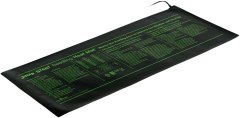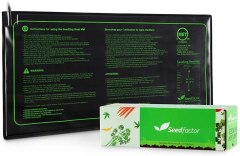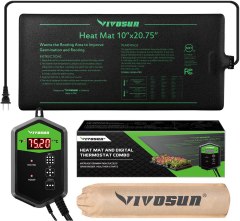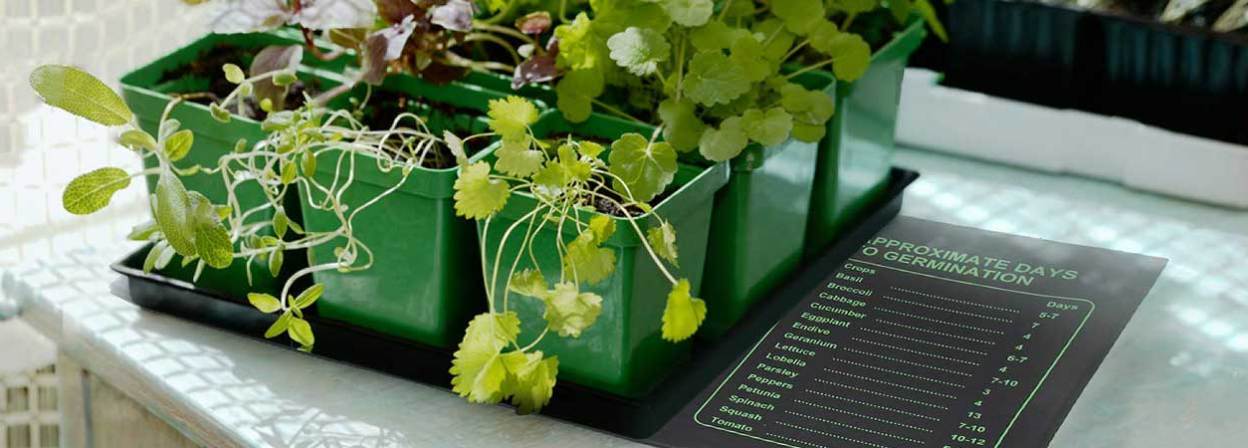BestReviews is reader-supported and may earn an affiliate commission. Details

Reliable brand delivers a quality plant heating mat that is built to last.
Reliable brand delivers a quality plant heating mat that is built to last.
Thick, durable mat stays flat and is available in multiple sizes. Germinates seeds in roughly half of the normal time. Heat is evenly distributed throughout the mat and stays at a consistent temperature. Power cord is 6 feet long.
Mat sits at a slightly higher price point.

Quality mat that sits at a low price point and gets the job done well.
Quality mat that sits at a low price point and gets the job done well.
Mat heats up quickly and evenly. Most seeds sprout within 3 to 7 days. The subtle heat helps move along the growth process without drying out your soil. Power connection is securely covered to protect from potential water spills.
Mat arrives rolled up and takes quite some time to flatten out.

Rest easy knowing you can set and regulate your mat's temperature with the conveniently included thermostat.
Rest easy knowing you can set and regulate your mat's temperature with the conveniently included thermostat.
Clear instructions make setup quick and simple. Included thermostat allows you to set and regulate the temperature. Plants typically sprout in about a week. Mat effectively keeps soil at a consistent temperature.
LED lights in the thermostat don't last very long, but it is still readable without lights.

The size and durability of this mat make it the perfect way to prepare a large garden.
The size and durability of this mat make it the perfect way to prepare a large garden.
Power cord is well hidden and doesn't obstruct use of the mat. Multilayered mat is waterproof and easy to wipe clean. Seeds sprout 2 to 5 days earlier than usual with this mat. Large 48 x 20-inch mat doesn't use too much energy.
Power cord is on the shorter side.

We recommend these products based on an intensive research process that's designed to cut through the noise and find the top products in this space. Guided by experts, we spend hours looking into the factors that matter, to bring you these selections.

Growing plants from seeds can be a challenge if you don't have optimal conditions, but not all of us live in warm climates or have heated greenhouses. Plant heating mats sit underneath trays of seedlings to warm the soil and provide a consistent temperature to promote germination. They're especially useful in areas where spring is chilly and there's a short growing season for summer veg and flowers.
There's plenty to consider when choosing your ideal plant heating mat. It needs to be the right size to fit the number of seedling trays you want it to accommodate but not so large that it won't fit in the spot you have planned for it. You might want features such as an adjustable thermostat to warm the soil to the perfect temperature for the seeds you’re germinating or a temperature probe to make sure the temperature is correct.
We've gathered all the information you need to make an informed purchase.

The majority of plant heating mats measure somewhere between 10 inches wide by 20 inches long and 20 inches wide by 48 inches long, though some are a little larger to factor in the extra room taken up by the edges of seedling trays. You can expect a plant heating mat to fit between one and four standard-size seed trays. Of course, you'll need to recalculate this if you’re using a different size seed tray.
Not only must you choose a plant heating mat that fits the number of trays you want it to hold, but it should also be the right size to fit its location, whether that's a windowsill, countertop, or potting bench. Some of the larger seedling mats are too big to fit in compact spots, so you might need to rethink the size of your mat or where you position it.
A plant heating mat with a thermostat allows you to control the temperature. Most seeds need soil temperatures somewhere between 70°F and 80°F for optimal germination, and heating mats without a thermostat usually heat somewhere between these two temperatures. While this is fine for most plants, it isn’t ideal for all of them, which limits the usefulness of the mat. A thermostat can allow you to set the temperature between roughly 40°F and 100°F. You won't need temperatures anywhere near these two extremes, but it gives you a wider range of options so you can tailor the temperature to suit specific seeds.

Some plant heating mats come with a probe or sensor to measure the temperature of the soil in the trays. While you can generally trust the heating mat to get it right, this gives you an extra degree of control that can be useful for finicky seeds that require precise temperatures. Plus, it allows you to tell if the soil is getting too warm, which could kill the seeds before they germinate.
If you live in the United States, you're most familiar with Fahrenheit as the temperature scale, so your heating mat thermostat should display temperatures in this scale. Some mats allow you to switch between that and Celsius, which is ideal if you're from a part of the world like Canada or the United Kingdom where this scale is commonly used.
Ideally, your chosen plant heating mat should have an automatic system that shuts it off if the mat starts to overheat. Not only will this protect your seedlings from damage, but it's also safer in case the unit malfunctions.
Check the seed packet to find the optimum temperature for germination.
Seedling trays: Living Whole Foods Plant Growing Trays
These standard 10 by 20-inch seedling trays don't have individual holes, so they're ideal for growing microgreens or for people who like to sow seeds haphazardly and then thin them out when they start to germinate. You can choose from packs of 5, 10, 50, or 100.
Propagation dome: Viagrow Clear Plastic Dome
Using a propagation dome provides a greenhouse-like environment in which seedlings can thrive, which is especially beneficial when you're growing early in the season. This dome has vents in the lid to keep it from getting overly moist and humid, which can damage the roots of seedlings.
Grow lights: yoyomax LED Grow Lights
If you're starting seedlings indoors, grow lights can make a world of difference in the health of your plants. Some people can grow seedlings on a sunny windowsill, but you can't beat full-spectrum grow lights for getting your plants the light they need. These lights are effective but not overly bulky, so they won't take over the whole room.
Inexpensive: The cheapest plant heating mats cost between $10 and $20. These are usually only large enough to fit a single tray of seedlings and may not have a thermostat to adjust the temperature.
Mid-range: For between $20 and $30, you can expect to find plant heating mats that can accommodate two trays and some that have an adjustable thermostat.
Expensive: The most expensive mats cost between $30 and $90. These can fit up to four seedling trays, almost always have a thermostat, and may have a probe or sensor to read the soil temperature.


A. Perhaps you already have a heating pad for aches and pains or a warming mat for pets to sleep on. Can you use that as a heating mat for your seedlings? The short answer is no. Heating mats for seedlings need to heat to specific temperatures so that they warm the soil enough to help seeds germinate quickly without overheating and killing them. This is a delicate balance that any other heating mat may not be able to accommodate. Plant heating mats are also waterproof or water-resistant so they won't get damaged if liquid spills or seeps onto them when watering your plants.
A. Yes, you need to leave your plant heating mat on 24 hours a day until the seeds germinate and start to poke up through the soil. It's particularly important that you not turn your heating mat off at night because this is when temperatures drop and the soil can get too cold for seeds to germinate. If you're concerned about energy use, know that seedling mats have an extremely low wattage and use very little power.
A. You might be wondering whether you really need a plant heating mat, so let's more closely examine the benefits of using one. Plant heating mats keep the soil consistently warm, which is ideal in spring when the temperature is fairly mild during the day but can drop to freezing at night in some areas. They speed up the germination process so you can grow more plants more quickly. You can also start earlier than you'd be able to without a heating mat, which extends the growing season. Seedling mats are perfect for trying new seeds to check their germination rate, since the faster germination means you won't need to wait so long to find out.
Get emails you’ll love.
Learn about the products you’re wondering if you should buy and get advice on using your latest purchases.
